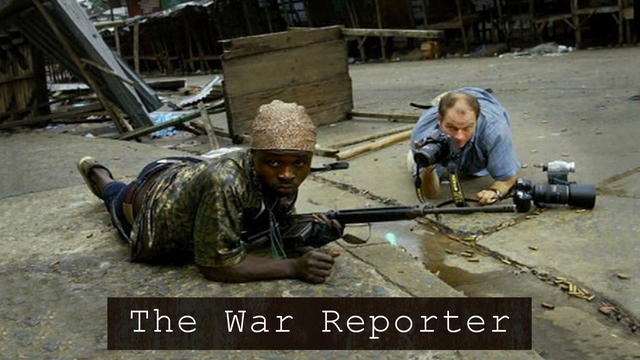From Somalia's painful struggles, to Liberia's apocalyptic civil war. In fact before he was killed Martin Adler recorded pretty much every war going. His blood-stained but very human dispatches helped define the way we saw foreign conflicts for over a decade. His quiet sensitivity while in the heart of darkness bought him awards and acclaim. For the first time his photographs and thousands of hours of video have been brought together to produce a riveting profile of an extraordinary man.
"This bloke knows what he's seen but he's not talking!", cries a US army troop embodying the gung ho attitude at the start of the Iraq war. Haunting scenes from Martin's life flash before our eyes - women sweeping the ground in the middle of a bombed-out Chechnya; a Liberian warlord holding an AK 47 in one hand and a baby in the other; desecrated landscapes from Uganda to Algeria. Martin allowed the images to speak for themselves, fuelled by a fearless curiosity, which would eventually get him killed:
"I want to go to the place where nobody else goes to and I want to listen to the people nobody else listens to".
It takes a particular kind of man to be a war reporter - living on your wits on an unsteady income, never knowing what the next day will bring. Yet as Martin's friends remember:
"he was not the kind of guy who could have done anything else". Riding along with Martin as we watch his fifteen year long journey through forty different war-ravaged countries, is a terrifying experience. In the hell of the Liberian Civil War, bodies fall like cards, splattering the camera with blood. Yet Martin always somehow manages to pull out the individual, as one of the warlords reminds us:
"We are fighting for our fucking lives!".
Beyond the 'bang and blood' of Martin's filming, so much of which made its way to our television screens, Martin made a quieter comment on our world of war. Yet almost inevitably, one day the barrel of the gun turned on Martin himself. In 2006, he was shot in the back in broad daylight, by what appears to have been an Islamic radical bent on disturbing Somalia's quest for peace. He left behind him an unbelievable legacy, and now has a journalistic award bearing his name.
"I can't imagine Martin sitting in a rocking chair as an old man", says his brother,
"he would never have experienced life reduced".
Producer: Anders Palm. Director: Thomas Nordanstad
CLICK ON THIS LINK TO SEE MARTIN ADLER'S NEWS FEATURES.
LEARN MORE.
WATCH MORE.
JOIN THE DISCUSSION.
 From Somalia's painful struggles, to Liberia's apocalyptic civil war. In fact before he was killed Martin Adler recorded pretty much every war going. His blood-stained but very human dispatches helped define the way we saw foreign conflicts for over a decade. His quiet sensitivity while in the heart of darkness bought him awards and acclaim. For the first time his photographs and thousands of hours of video have been brought together to produce a riveting profile of an extraordinary man.
From Somalia's painful struggles, to Liberia's apocalyptic civil war. In fact before he was killed Martin Adler recorded pretty much every war going. His blood-stained but very human dispatches helped define the way we saw foreign conflicts for over a decade. His quiet sensitivity while in the heart of darkness bought him awards and acclaim. For the first time his photographs and thousands of hours of video have been brought together to produce a riveting profile of an extraordinary man.




